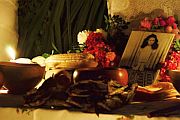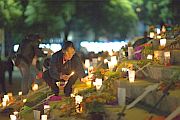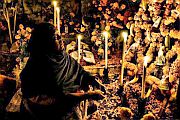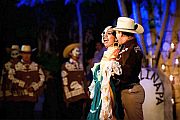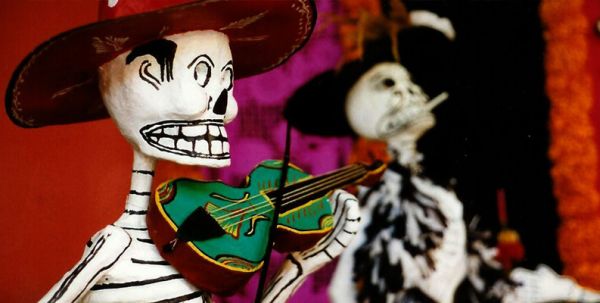Mexico's festivities for the annual Dead of the Dead holiday (Día de Los Muertos in Spanish) will kick off in less than two weeks, which means now is the perfect time for some travel tips. If you haven't made any plans, consider this a guide for a last-minute getaway... or for a Day of the Dead 2017 trip planned well in advance.
Here are seven destinations in Mexico where you can "live it up" on the Day of the Dead:
Aguascalientes
The yearly Day of the Dead festival in the north-central Mexican state of Aguascalientes is called the
Festival de las Calaveras or "Festival of Skulls." It celebrates the pre-Hispanic tradition of the "cult of death" with colorful cemetery celebrations and images of
La Calavera Catrina, also known as the "Dapper Skeleton," "Elegant Skull," or "Skull of the Female Dandy." These first appeared in etchings by the famous Mexican printmaker, illustrator, and lithographer José Guadalupe Posada, who was born in the state back in 1852. Fitting for the Day of the Dead, it's worth noting that Posada's works weren't fully appreciated until after his death.
Cuernavaca
In Cuernavaca, the capital of the Morelos state, there is an eight-day celebration for the Day of the Dead. In each morning and evening, the spirits are believed to walk the streets and visit places they frequented back when they were still alive. In order to greet them, stalls are set up in the streets, selling everything the living need to decorate altars including flowers, candles, incense, sugar skulls, and pumpkins. On Oct. 31 and Nov. 1, bells ring all over town while Masses take place to honor the dead.
Mérida
The Day of the Dead is called
Hanal Pixán by the Maya people living on the Yucatán Peninsula. This translates to "feast for the souls" or "food of souls," which means cuisine plays a big role in this region. As it is believed that spirits will return to visit their families during this time, extra care is taken to prepare unique Mayan dishes such as
mucbipollo, which are similar to tamales but larger. They consist of corn dough and chicken wrapped in banana leaves, which are traditionally cooked in an underground pib or, more recently, a wood-fired oven. The food is set out on a table and after the spirits have their fill, the living can join in on the feast. An extra place setting is often put out for the lonely souls who don't have anyone to remember them.
Mixquic
Located just outside the urban metropolis of Mexico City is the small village of Mixquic, which retains strong ties to its indigenous roots. In the days leading up to the festivities, street stalls will start popping up all over selling food, crafts, and other items. Although many homes are already decorated with excavated skulls (and a local monastery erects a shrine of real human bones that are decorated for the Day of the Dead), residents will place large paper star lanterns over their doorways from mid-October until Nov. 3. On Nov. 1, a mock funeral procession is held in which participants carry a cardboard coffin and solicit contributions on the way to the cemetery for a candlelight vigil. However, when they arrive at the graveyard, a very-much-alive man will usually jump out of the coffin and run off for the amusement of the crowd. Due to its notoriety, Mixquic is quickly becoming one of the most popular places in Mexico to celebrate the Day of the Dead.
Oaxaca
Oaxaca is a great place to visit year-round, but a trip for the Day of the Dead will allow tourists to experience all of the cemetery vigils, nighttime carnival-like parades (featuring a group of singers, musicians, and dancers called a
comparsa), and an elaborate sand tapestry competition. Although the timing doesn't line up this year (as the celebrations last from Monday to Wednesday), if you can manage to stay until Friday, the famous market in Ocotlán is not to be missed. Here you can buy flowers, clothing, fresh fruit and vegetables, ice cream, and maybe even some live animals.
Patzcuaro Lake
If you want to stay near water but aren't into the whole ocean thing, opt for Patzcuaro Lake in the state of Michoacán. Not only is it breathtaking to see countless torch-holding fishermen in rowboats all around the lake, but the small island of Janitzio is home to the indigenous Tarascans/Purépecha people, who have some of the most elaborate Day of the Dead rituals around. This includes processions, music, folk dances, and chanting and signing in cemeteries all night long.
Riviera Maya
As someone who just returned from the Riviera Maya, I can assure you that it will be beautiful and enjoyable at any time of year, however, visiting for the Day of the Dead is the absolute best time. The Xcaret ecological theme park hosts an annual
Festival de la Vida y la Muerte ("Festival of Life and Death") from Oct. 30 to Nov. 2 that includes face-painting (if you want to rock that skeleton or sugar skull look), theater and dance performances, concerts, conferences, parades and special tours, in addition to the usual Day of the Dead rituals and Xcaret activities (like snorkeling in an underground river and visiting a Mayan archaeological site).
Read the full article on TheDailyMeal.com.

